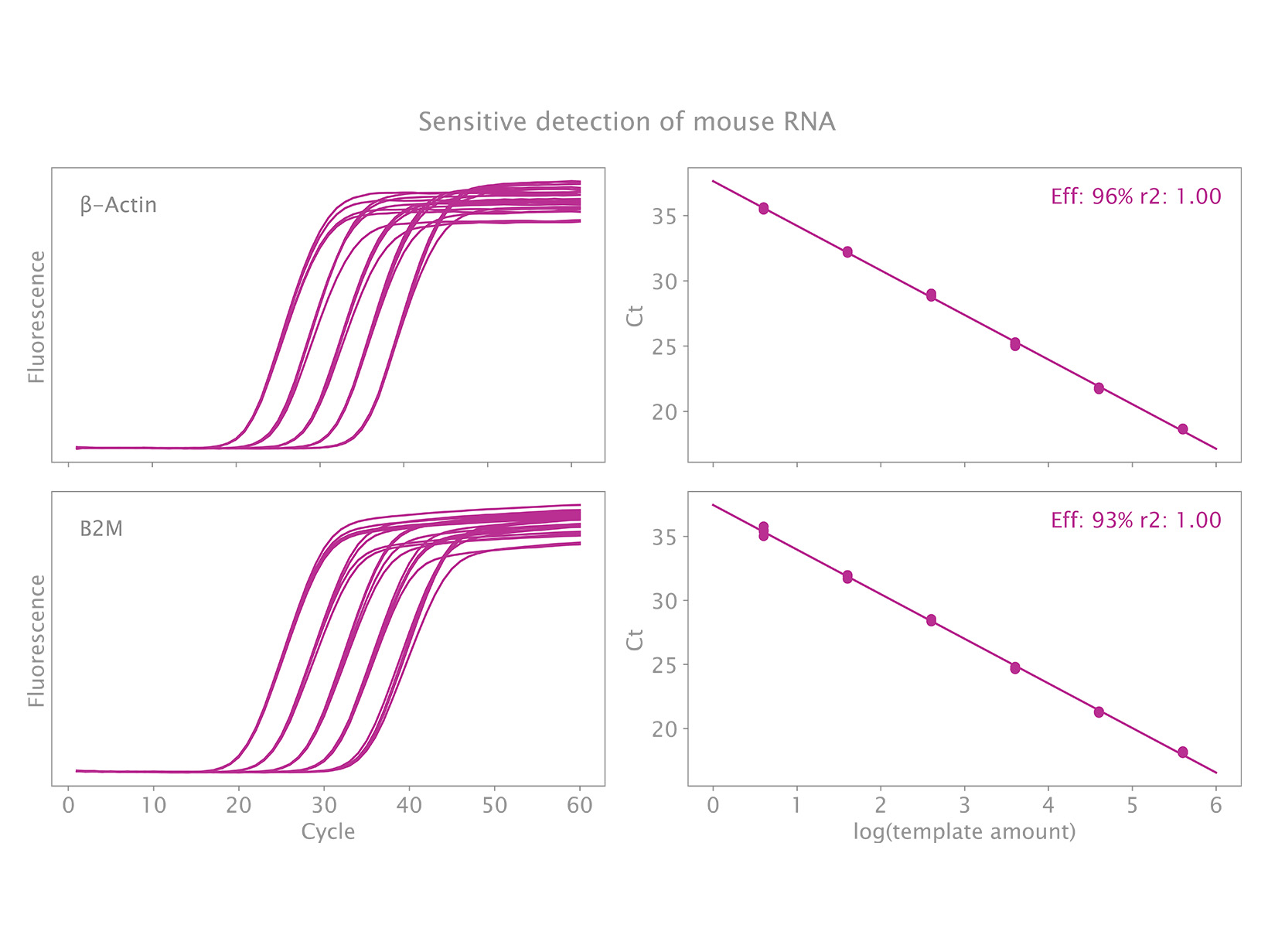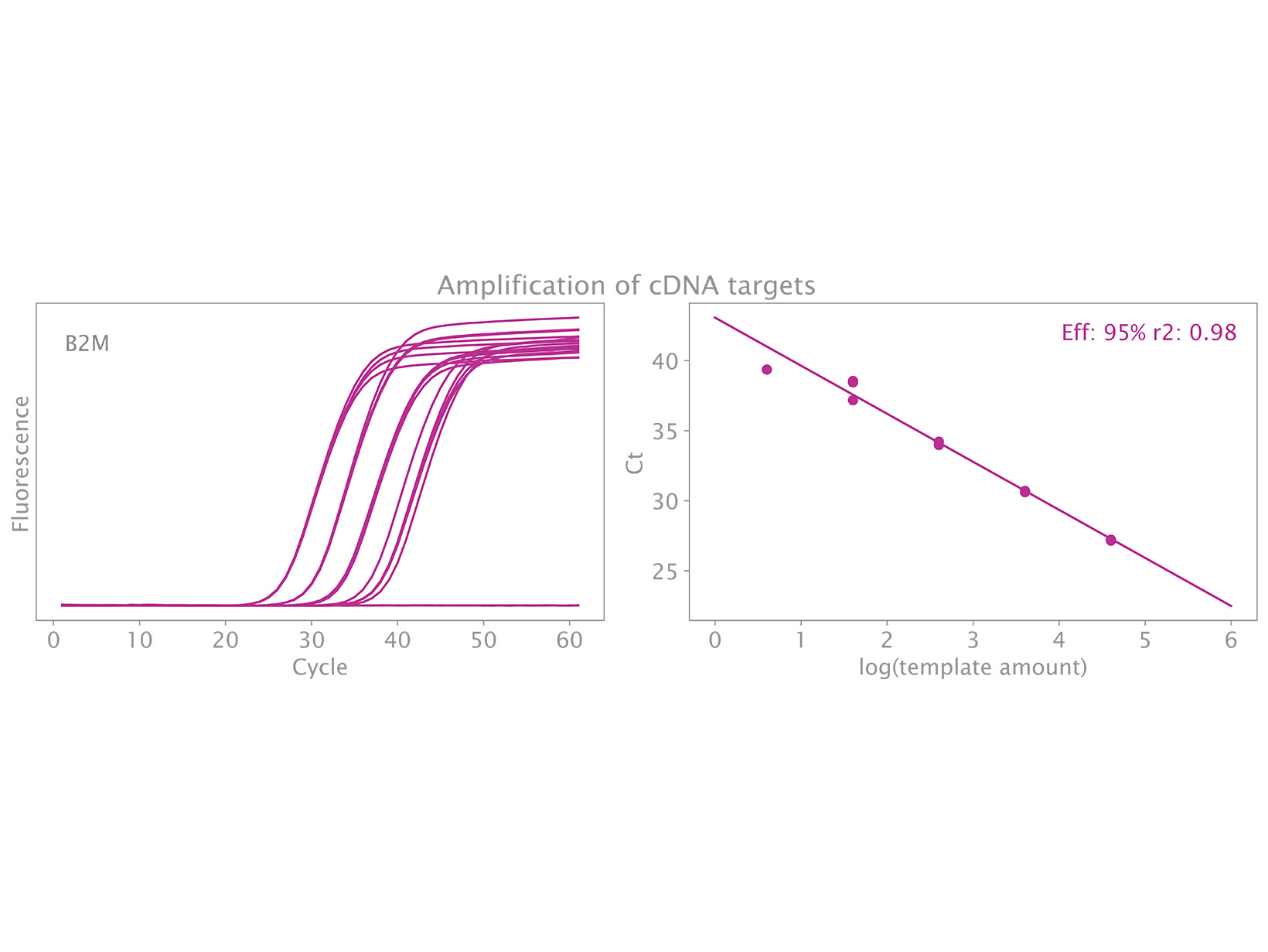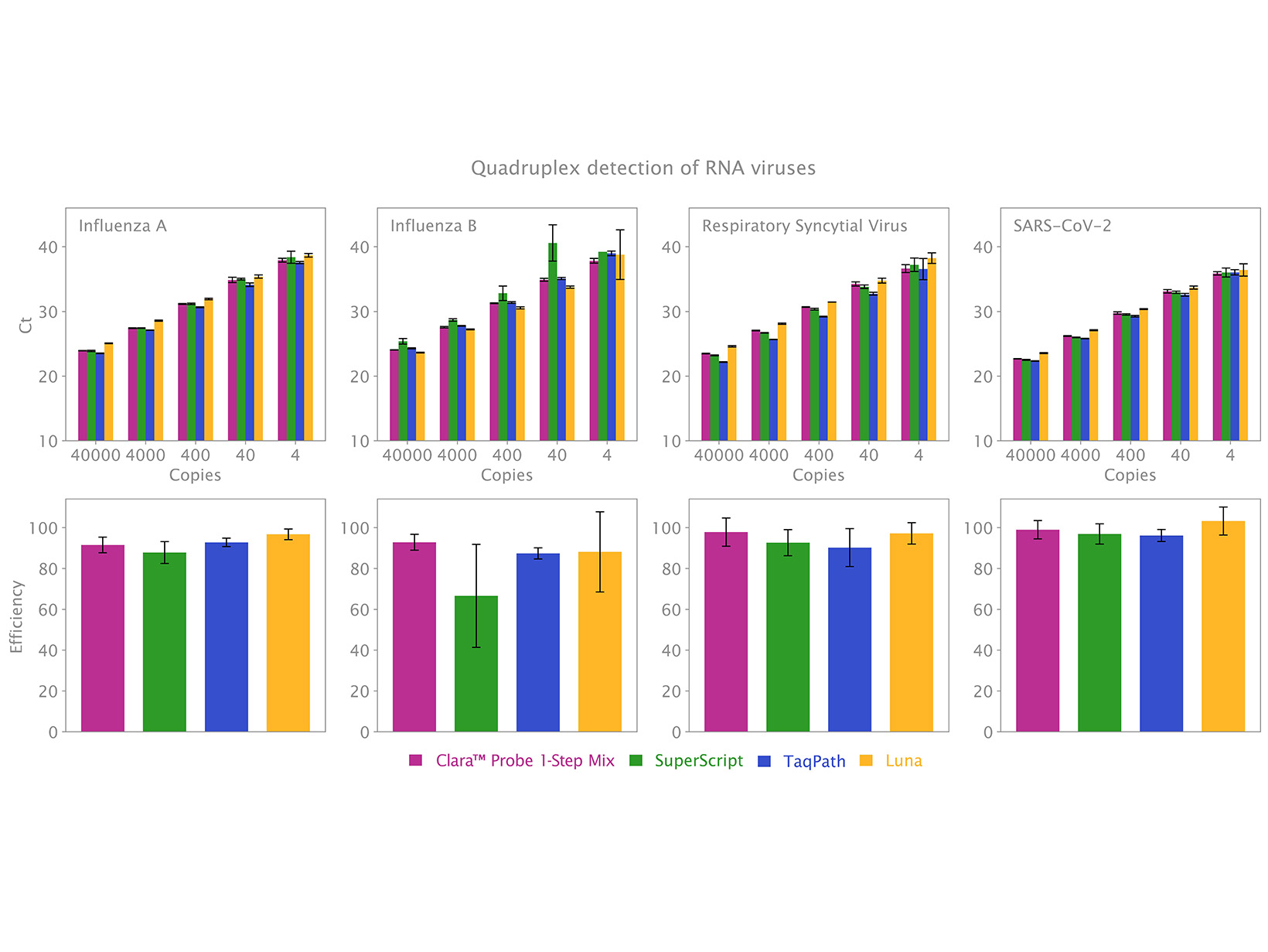To view your price please login or contact us
Clara™ Probe 1-Step Purple Mix
Clara™ Probe 1-Step Purple Mix offers clear and consistent results every time, with an easy-to-see, inert, purple dye for sample visualisation. This new single tube RT-qPCR mix is suitable for universal probe-based detection of RNA and DNA targets in single and multiplex assays.
Clara™ Probe 1-Step Purple Mix is a carefully balanced 4x RT-qPCR mix that combines maximum sensitivity with ease-of-use for streamlined 1-step probe RT-qPCR workflows. As a result, the mix shows no loss of efficiency in amplifying DNA or RNA and is ideal for users who detect both types of targets without the requirement for separate qPCR reagents.
Features:
- Concentrated 4x mix format, ideal for high-throughput, highly multiplexed assays
- Inert purple dye for easy visualisation during setup
- Superior detection of RNA & DNA targets
- Reliable quantification of low copy templates
- Early detection of a wide range of template amounts
- Contains modified UltraScript™ RTase in a single-tube format
- Advanced RNase inhibitor
- Antibody-mediated hot start technology
- Compatible with all real-time PCR platforms – standard and fast cycling conditions
More Information
Probe 1-step qPCR mix – Clear Results, Reliable Conclusions
Clara™ Probe 1-Step Purple Mix enables qPCR and 1-step RT-qPCR with the highest sensitivity, reliability, and with the greatest ease of use in diagnostic applications and basic research alike. It is a universal qPCR mix suitable for all types of probe technologies, including TaqMan®, Scorpions® and molecular beacons. This is our first generation of all-in-one 1-step RT-qPCR mixes, where both the DNA polymerase and reverse transcriptase are included in the same mastermix. Clara™ Probe 1-Step Purple Mix is powered by our unique hot start Taq DNA polymerase and a specially modified version of our high performance, thermostable UltraScript™ Reverse Transcriptase. Rigorous testing during development makes this mix highly suitable for both single and multiplex detection with high efficiency and sensitive detection whether you’re detecting one target or many simultaneously.
The mix is also suitable for melt-curve analysis (with hybridisation probes only) and is available without passive reference dye (No-ROX), or with reverence dye as Lo-ROX, Hi-ROX and separate-ROX formulations. Use our qPCR Selection Tool to find out which ROX variant is compatible with your instrument.
Easy to see purple dye
Clara™ Probe 1-Step Purple Mix combines the speed, sensitivity and specificity of the Clara™ reagent family with an inert purple dye for easy sample visualisation. The dye has greatly reduced quenching of probe fluorophores, to ensure accurate qPCR results, while reducing handling and pipetting
Decreases in probe fluorescent intensity for in Clara™ Probe 1-Step Purple Mixes:
FAM: up to 25%
HEX: up to 30%
Tex: up to 25%
Cy5: up to 10%
The percentages represent the plateau height reduction (Purple mix vs basic mix) in at least two different reactions
Get the greatest ease-of-use
Our proprietary buffer composition (identified via smart screen technology) and uniquely modified UltraScript™ RTase allow the mix to be stored in a single tube, as all-in-one, RT-qPCR mastermix. This reduces the amount of pipetting needed for assay setup, minimising the risk of contamination, and saving time. It also means that one reagent is suitable for amplification of DNA and RNA and both target types can be included on the same plate or in the same run. Having one mix means you do not require a different setup when primarily investigating RNA targets, but still requiring DNA quantification.
While users who test large quantities of both target types of targets may prefer dedicated reagents for each target type, Clara™ Probe Purple Mix is developed exclusively for DNA and cDNA probe-based detection.
Improve reliability of real time PCR
Extensive optimization makes this mix suitable for all nucleic acid target types. We have tested it against common RNA viruses, including SARS-CoV-2, RSV, Influenza A, and B, standard housekeeping genes, such as g-actin and GAPDH, as well as DNA targets. The presence of RTase in the mix does not affect direct amplification of DNA targets, meaning you get the same high efficiency whether you’re detecting DNA or RNA sequences. The mix is highly stable and shows strong reproducibility between runs, giving your data reproducibility and confidence in the experimental conclusions you draw.
Maximise 1-step qPCR sensitivity
The high concentration 4x mix format of Clara™ Probe 1-Step Purple Mix offers greater sensitivity and flexibility by allowing more sample to be added to each reaction, and for smaller reaction volumes to be used with confidence. Fast amplification allows for earlier Cts and permits reliable detection of down to four target copies per 20 μL reaction (0.8 copies per μL). Get the superior detection even in the most dilute samples.
Need help with probe based qPCR experimental design?
Be sure to design primers and probes carefully. For efficient amplification under fast cycling conditions we recommend amplicon lengths between 80 bp and 200 bp. With all manufacturers master mixes the shorter the amplicon length the faster the reaction can be cycled. Amplicon lengths should not exceed 400 bp. Primers should have a predicted melting temperature of around 60 °C, using default Primer 3 settings (https://bioinfo.ut.ee/primer3/). For TaqMan® probes choose probe close to 5’ primer, avoid terminal guanosine residues. Ensure ideal probe dye and quencher combinations, especially in multiplexed reactions.
For further information on how to design qPCR experiments and analyse qPCR results, please refer to our technical guide.
Applications
- Gene expression analysis
- Genotyping
- In vitro diagnostic kit development
- Single & multiplex RNA & DNA detection
Specifications
Clara™ Probe 1-Step Purple Mix Lo-ROX
Component
200 Reactions
600 Reactions
1000 Reactions
10 000 Reactions
4x Clara™ Probe 1-Step Purple Mix Lo-ROX
1 x 1 mL
3 x 1 mL
5 x 1 mL
1 x 50 mL
Clara™ Probe 1-Step Purple Mix Hi-ROX
Component
200 Reactions
600 Reactions
1000 Reactions
10 000 Reactions
4x Clara™ Probe 1-Step Purple Mix Hi-ROX
1 x 1 mL
3 x 1 mL
5 x 1 mL
1 x 50 mL
Clara™ Probe 1-Step Purple Mix No-ROX
Component
200 Reactions
600 Reactions
1000 Reactions
10 000 Reactions
4x Clara™ Probe 1-Step Purple Mix No-ROX
1 x 1 mL
3 x 1 mL
5 x 1 mL
1 x 50 mL
Clara™ Probe 1-Step Purple Mix Separate-ROX
Component
200 Reactions
600 Reactions
1000 Reactions
4x Clara™ Probe 1-Step Purple Mix No-ROX
1 x 1 mL
3 x 1 mL
5 x 1 mL
50 μΜ ROX Additive
1 x 200 μL
1 x 200 μL
1 x 200 μL
Clara™ Probe 1-Step Purple Mix Lo-ROX
Component
4x Clara™ Probe 1-Step Purple Mix Lo-ROX
200 Reactions
1 x 1 mL
600 Reactions
3 x 1 mL
1000 Reactions
5 x 1 mL
10 000 Reactions
1 x 50 mL
Clara™ Probe 1-Step Purple Mix Hi-ROX
Component
4x Clara™ Probe 1-Step Purple Mix Hi-ROX
200 Reactions
1 x 1 mL
600 Reactions
3 x 1 mL
1000 Reactions
5 x 1 mL
10 000 Reactions
1 x 50 mL
Clara™ Probe 1-Step Purple Mix No-ROX
Component
4x Clara™ Probe 1-Step Purple Mix No-ROX
200 Reactions
1 x 1 mL
600 Reactions
3 x 1 mL
1000 Reactions
5 x 1 mL
10 000 Reactions
1 x 50 mL
Clara™ Probe 1-Step Purple Mix Separate-ROX
Component
4x Clara™ Probe 1-Step Purple Mix No-ROX
50 μΜ ROX Additive
200 Reactions
1 x 1 mL
1 x 200 μL
600 Reactions
3 x 1 mL
1 x 200 μL
1000 Reactions
5 x 1 mL
1 x 200 μL
Reaction Volume
Storage
20 μL
On arrival, products should be stored between -30 and -15 °C. If stored correctly the kit will retain full activity for 12 months.
Reaction Volume
20 μL
Storage
On arrival, products should be stored between -30 and -15 °C. If stored correctly the kit will retain full activity for 12 months.
Instrument Compatibility
This product is compatible with all standard and fast cycling qPCR instruments. Use our qPCR Selection Tool to find out which ROX variant is compatible with your instrument.
Documents
Product Flyers
Product Manuals
Material Safety Data Sheets
Certificate of Analysis Finder
FAQs
Can Clara™ Probe 1-Step Mix and Purple Mix be used for both 1-step and 2-step RT-PCR?
Yes. Clara™ Probe 1-Step Mix can amplify cDNA and RNA targets equally well. However, since this mix contains RTase, it is ideal for 1-step workflows. We recommend using Clara™ Probe 1-Step Mix for 1-step workflows and where experiments require DNA detection in a limited number of samples, and Clara™ Probe Mix for 2-step protocols and routine DNA detection.
Can products generated with Clara™ and Clara™ Purple mixes be digested, cloned, and sequenced?
Yes, PCR products generated with these mixes have the same characteristics as PCR products generated with wild-type Taq polymerase. They may be sequenced or digested with restriction endonucleases using standard protocols. Products are 3′-d(A)-tailed and may be used for TA cloning or may be blunt-ended or digested with restriction enzymes prior to cloning. For best results, we recommend purifying the PCR products using any standard PCR clean-up kit.
Do Clara™ Probe Mix and Clara™ Probe 1-Step Mix contain the FAM dye in it?
No. Apart from ROX (if present in the kit), there is no other dye in our mixes. You can therefore use any fluorophore-conjugated probe for your reaction.
Is it normal if the fluorescence of Clara™ Probe Mix and Clara™ Probe 1-Step Mix differs from the one obtained with competitors’ products?
Different products could give a different plateau of fluorescence. However, this has no impact on quantification accuracy and Ct values will not differ among products.
Is the storage of sample DNA in 1x TE (10 mM Tris-HCl / 1 mM EDTA) buffer compatible with subsequent qPCR using Clara™ Probe Mix and Clara™ Probe 1-Step Mix?
Yes, this storage buffer is compatible. The EDTA will chelate some of the magnesium in the mix, but not significantly enough to affect the reaction.
What are the ROX concentrations in Clara™ Probe Mix, Clara™ Probe 1-Step Mix and corresponding purple mixes?
The Clara™ Probe Purple and Clara™ Probe 1-Step Purple Mixes that contain passive reference dyes come in different formulations, each with a different concentration of the passive reference dye:
Lo-ROX mixes (PB20.65 and PB25.85) contain 200 nM ROX.
Hi-ROX mixes (PB20.66 and PB25.86) contain 2 µM ROX.
No-ROX mixes (PB20.67 and PB25.87) do not contain ROX.
Separate-ROX mixes (PB20.68 and PB25.88) include a separate tube of 50 µM ROX additive. This enables you to choose what concentration of ROX you’d like to use.
You can use our qPCR Selection Tool under the Resources drop-down menu to determine which of our mixes are best suited for your qPCR machine.
What troubleshooting is recommended if there are non-specific products in my qPCR?
There are different options to consider when optimising the reaction:
Reduce the annealing/extension time to 5 seconds
Increase the annealing/extension temperature from 60 to 65°C
Dilute the DNA template by starting with 5ng of DNA and using a 10x template dilution series. In addition to running these on a gel to see if the non-specific products persist, the efficiency of the reaction can be calculated with the software of the qPCR instrument after doing the template dilution. If the efficiency is between 90 – 110%, then the amplicon is being doubled every cycle.
Will this mix work for micro RNA templates?
Yes, Clara Probe 1-Step Mix can be used for micro RNA templates. Although we do no sell dedicated kits, all of our RTases can be used for miRNA quantification and analysis.
We advise that you use one of the two following approaches:
Use universal RT primers and add poly(A) or poly(U) tails (e.g. by poly(U)-polymerase), followed by cDNA synthesis using universal primers1,2.
Use specific RT primers and omit the tailing step1,3-5.
If you are unfamiliar with the specifics of those approaches, please refer to the reference list below, which serve as a guideline.
1 Dave, V. P. et al. MicroRNA amplification and detection technologies: opportunities and challenges for point of care diagnostics. Lab Invest 99, 452-469, doi:10.1038/s41374-018-0143-3 (2019).
2 Mei, Q. et al. A facile and specific assay for quantifying microRNA by an optimized RT-qPCR approach. PLoS One 7, e46890, doi:10.1371/journal.pone.0046890 (2012).
3 Chen, C. et al. Real-time quantification of microRNAs by stem-loop RT-PCR. Nucleic Acids Res 33, e179, doi:10.1093/nar/gni178 (2005).
4 Raymond, C. K., Roberts, B. S., Garrett-Engele, P., Lim, L. P. & Johnson, J. M. Simple, quantitative primer-extension PCR assay for direct monitoring of microRNAs and short-interfering RNAs. RNA 11, 1737-1744, doi:10.1261/rna.2148705 (2005).
5 Androvic, P., Valihrach, L., Elling, J., Sjoback, R. & Kubista, M. Two-tailed RT-qPCR: a novel method for highly accurate miRNA quantification. Nucleic Acids Res 45, e144, doi:10.1093/nar/gkx588 (2017).
More Information
Probe 1-step qPCR mix – Clear Results, Reliable Conclusions
Clara™ Probe 1-Step Purple Mix enables qPCR and 1-step RT-qPCR with the highest sensitivity, reliability, and with the greatest ease of use in diagnostic applications and basic research alike. It is a universal qPCR mix suitable for all types of probe technologies, including TaqMan®, Scorpions® and molecular beacons. This is our first generation of all-in-one 1-step RT-qPCR mixes, where both the DNA polymerase and reverse transcriptase are included in the same mastermix. Clara™ Probe 1-Step Purple Mix is powered by our unique hot start Taq DNA polymerase and a specially modified version of our high performance, thermostable UltraScript™ Reverse Transcriptase. Rigorous testing during development makes this mix highly suitable for both single and multiplex detection with high efficiency and sensitive detection whether you’re detecting one target or many simultaneously.
The mix is also suitable for melt-curve analysis (with hybridisation probes only) and is available without passive reference dye (No-ROX), or with reverence dye as Lo-ROX, Hi-ROX and separate-ROX formulations. Use our qPCR Selection Tool to find out which ROX variant is compatible with your instrument.
Easy to see purple dye
Clara™ Probe 1-Step Purple Mix combines the speed, sensitivity and specificity of the Clara™ reagent family with an inert purple dye for easy sample visualisation. The dye has greatly reduced quenching of probe fluorophores, to ensure accurate qPCR results, while reducing handling and pipetting
Decreases in probe fluorescent intensity for in Clara™ Probe 1-Step Purple Mixes:
FAM: up to 25%
HEX: up to 30%
Tex: up to 25%
Cy5: up to 10%
The percentages represent the plateau height reduction (Purple mix vs basic mix) in at least two different reactions
Get the greatest ease-of-use
Our proprietary buffer composition (identified via smart screen technology) and uniquely modified UltraScript™ RTase allow the mix to be stored in a single tube, as all-in-one, RT-qPCR mastermix. This reduces the amount of pipetting needed for assay setup, minimising the risk of contamination, and saving time. It also means that one reagent is suitable for amplification of DNA and RNA and both target types can be included on the same plate or in the same run. Having one mix means you do not require a different setup when primarily investigating RNA targets, but still requiring DNA quantification.
While users who test large quantities of both target types of targets may prefer dedicated reagents for each target type, Clara™ Probe Purple Mix is developed exclusively for DNA and cDNA probe-based detection.
Improve reliability of real time PCR
Extensive optimization makes this mix suitable for all nucleic acid target types. We have tested it against common RNA viruses, including SARS-CoV-2, RSV, Influenza A, and B, standard housekeeping genes, such as g-actin and GAPDH, as well as DNA targets. The presence of RTase in the mix does not affect direct amplification of DNA targets, meaning you get the same high efficiency whether you’re detecting DNA or RNA sequences. The mix is highly stable and shows strong reproducibility between runs, giving your data reproducibility and confidence in the experimental conclusions you draw.
Maximise 1-step qPCR sensitivity
The high concentration 4x mix format of Clara™ Probe 1-Step Purple Mix offers greater sensitivity and flexibility by allowing more sample to be added to each reaction, and for smaller reaction volumes to be used with confidence. Fast amplification allows for earlier Cts and permits reliable detection of down to four target copies per 20 μL reaction (0.8 copies per μL). Get the superior detection even in the most dilute samples.
Need help with probe based qPCR experimental design?
Be sure to design primers and probes carefully. For efficient amplification under fast cycling conditions we recommend amplicon lengths between 80 bp and 200 bp. With all manufacturers master mixes the shorter the amplicon length the faster the reaction can be cycled. Amplicon lengths should not exceed 400 bp. Primers should have a predicted melting temperature of around 60 °C, using default Primer 3 settings (https://bioinfo.ut.ee/primer3/). For TaqMan® probes choose probe close to 5’ primer, avoid terminal guanosine residues. Ensure ideal probe dye and quencher combinations, especially in multiplexed reactions.
For further information on how to design qPCR experiments and analyse qPCR results, please refer to our technical guide.
Applications
- Gene expression analysis
- Genotyping
- In vitro diagnostic kit development
- Single & multiplex RNA & DNA detection
Specifications
Clara™ Probe 1-Step Purple Mix Lo-ROX
Component
200 Reactions
600 Reactions
1000 Reactions
10 000 Reactions
4x Clara™ Probe 1-Step Purple Mix Lo-ROX
1 x 1 mL
3 x 1 mL
5 x 1 mL
1 x 50 mL
Clara™ Probe 1-Step Purple Mix Hi-ROX
Component
200 Reactions
600 Reactions
1000 Reactions
10 000 Reactions
4x Clara™ Probe 1-Step Purple Mix Hi-ROX
1 x 1 mL
3 x 1 mL
5 x 1 mL
1 x 50 mL
Clara™ Probe 1-Step Purple Mix No-ROX
Component
200 Reactions
600 Reactions
1000 Reactions
10 000 Reactions
4x Clara™ Probe 1-Step Purple Mix No-ROX
1 x 1 mL
3 x 1 mL
5 x 1 mL
1 x 50 mL
Clara™ Probe 1-Step Purple Mix Separate-ROX
Component
200 Reactions
600 Reactions
1000 Reactions
4x Clara™ Probe 1-Step Purple Mix No-ROX
1 x 1 mL
3 x 1 mL
5 x 1 mL
50 μΜ ROX Additive
1 x 200 μL
1 x 200 μL
1 x 200 μL
Clara™ Probe 1-Step Purple Mix Lo-ROX
Component
4x Clara™ Probe 1-Step Purple Mix Lo-ROX
200 Reactions
1 x 1 mL
600 Reactions
3 x 1 mL
1000 Reactions
5 x 1 mL
10 000 Reactions
1 x 50 mL
Clara™ Probe 1-Step Purple Mix Hi-ROX
Component
4x Clara™ Probe 1-Step Purple Mix Hi-ROX
200 Reactions
1 x 1 mL
600 Reactions
3 x 1 mL
1000 Reactions
5 x 1 mL
10 000 Reactions
1 x 50 mL
Clara™ Probe 1-Step Purple Mix No-ROX
Component
4x Clara™ Probe 1-Step Purple Mix No-ROX
200 Reactions
1 x 1 mL
600 Reactions
3 x 1 mL
1000 Reactions
5 x 1 mL
10 000 Reactions
1 x 50 mL
Clara™ Probe 1-Step Purple Mix Separate-ROX
Component
4x Clara™ Probe 1-Step Purple Mix No-ROX
50 μΜ ROX Additive
200 Reactions
1 x 1 mL
1 x 200 μL
600 Reactions
3 x 1 mL
1 x 200 μL
1000 Reactions
5 x 1 mL
1 x 200 μL
Reaction Volume
Storage
20 μL
On arrival, products should be stored between -30 and -15 °C. If stored correctly the kit will retain full activity for 12 months.
Reaction Volume
20 μL
Storage
On arrival, products should be stored between -30 and -15 °C. If stored correctly the kit will retain full activity for 12 months.
Instrument Compatibility
This product is compatible with all standard and fast cycling qPCR instruments. Use our qPCR Selection Tool to find out which ROX variant is compatible with your instrument.
Documents
Product Flyers
Product Manuals
Material Safety Data Sheets
Certificate of Analysis Finder
FAQs
Can Clara™ Probe 1-Step Mix and Purple Mix be used for both 1-step and 2-step RT-PCR?
Yes. Clara™ Probe 1-Step Mix can amplify cDNA and RNA targets equally well. However, since this mix contains RTase, it is ideal for 1-step workflows. We recommend using Clara™ Probe 1-Step Mix for 1-step workflows and where experiments require DNA detection in a limited number of samples, and Clara™ Probe Mix for 2-step protocols and routine DNA detection.
Can products generated with Clara™ and Clara™ Purple mixes be digested, cloned, and sequenced?
Yes, PCR products generated with these mixes have the same characteristics as PCR products generated with wild-type Taq polymerase. They may be sequenced or digested with restriction endonucleases using standard protocols. Products are 3′-d(A)-tailed and may be used for TA cloning or may be blunt-ended or digested with restriction enzymes prior to cloning. For best results, we recommend purifying the PCR products using any standard PCR clean-up kit.
Do Clara™ Probe Mix and Clara™ Probe 1-Step Mix contain the FAM dye in it?
No. Apart from ROX (if present in the kit), there is no other dye in our mixes. You can therefore use any fluorophore-conjugated probe for your reaction.
Is it normal if the fluorescence of Clara™ Probe Mix and Clara™ Probe 1-Step Mix differs from the one obtained with competitors’ products?
Different products could give a different plateau of fluorescence. However, this has no impact on quantification accuracy and Ct values will not differ among products.
Is the storage of sample DNA in 1x TE (10 mM Tris-HCl / 1 mM EDTA) buffer compatible with subsequent qPCR using Clara™ Probe Mix and Clara™ Probe 1-Step Mix?
Yes, this storage buffer is compatible. The EDTA will chelate some of the magnesium in the mix, but not significantly enough to affect the reaction.
What are the ROX concentrations in Clara™ Probe Mix, Clara™ Probe 1-Step Mix and corresponding purple mixes?
The Clara™ Probe Purple and Clara™ Probe 1-Step Purple Mixes that contain passive reference dyes come in different formulations, each with a different concentration of the passive reference dye:
Lo-ROX mixes (PB20.65 and PB25.85) contain 200 nM ROX.
Hi-ROX mixes (PB20.66 and PB25.86) contain 2 µM ROX.
No-ROX mixes (PB20.67 and PB25.87) do not contain ROX.
Separate-ROX mixes (PB20.68 and PB25.88) include a separate tube of 50 µM ROX additive. This enables you to choose what concentration of ROX you’d like to use.
You can use our qPCR Selection Tool under the Resources drop-down menu to determine which of our mixes are best suited for your qPCR machine.
What troubleshooting is recommended if there are non-specific products in my qPCR?
There are different options to consider when optimising the reaction:
Reduce the annealing/extension time to 5 seconds
Increase the annealing/extension temperature from 60 to 65°C
Dilute the DNA template by starting with 5ng of DNA and using a 10x template dilution series. In addition to running these on a gel to see if the non-specific products persist, the efficiency of the reaction can be calculated with the software of the qPCR instrument after doing the template dilution. If the efficiency is between 90 – 110%, then the amplicon is being doubled every cycle.
Will this mix work for micro RNA templates?
Yes, Clara Probe 1-Step Mix can be used for micro RNA templates. Although we do no sell dedicated kits, all of our RTases can be used for miRNA quantification and analysis.
We advise that you use one of the two following approaches:
Use universal RT primers and add poly(A) or poly(U) tails (e.g. by poly(U)-polymerase), followed by cDNA synthesis using universal primers1,2.
Use specific RT primers and omit the tailing step1,3-5.
If you are unfamiliar with the specifics of those approaches, please refer to the reference list below, which serve as a guideline.
1 Dave, V. P. et al. MicroRNA amplification and detection technologies: opportunities and challenges for point of care diagnostics. Lab Invest 99, 452-469, doi:10.1038/s41374-018-0143-3 (2019).
2 Mei, Q. et al. A facile and specific assay for quantifying microRNA by an optimized RT-qPCR approach. PLoS One 7, e46890, doi:10.1371/journal.pone.0046890 (2012).
3 Chen, C. et al. Real-time quantification of microRNAs by stem-loop RT-PCR. Nucleic Acids Res 33, e179, doi:10.1093/nar/gni178 (2005).
4 Raymond, C. K., Roberts, B. S., Garrett-Engele, P., Lim, L. P. & Johnson, J. M. Simple, quantitative primer-extension PCR assay for direct monitoring of microRNAs and short-interfering RNAs. RNA 11, 1737-1744, doi:10.1261/rna.2148705 (2005).
5 Androvic, P., Valihrach, L., Elling, J., Sjoback, R. & Kubista, M. Two-tailed RT-qPCR: a novel method for highly accurate miRNA quantification. Nucleic Acids Res 45, e144, doi:10.1093/nar/gkx588 (2017).










